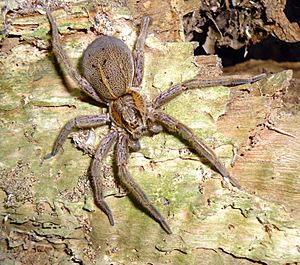Dolomedes schauinslandi facts for kids
Quick facts for kids Dolomedes schauinslandi |
|
|---|---|
 |
|
| Rangatira spider on Mangere Island, New Zealand | |
| Scientific classification |
The Rangatira spider, also known as Dolomedes schauinslandi, is a very large spider. It belongs to a group called nursery web spiders. This special spider lives only on a few small islands in New Zealand. These islands are Rangatira (South East Island), Houruakopara, and Mangere Island, all part of the Chatham Islands. It is one of the biggest and rarest spiders found in New Zealand.
Contents
What Does It Look Like?
This big spider was first described in 1899 by a scientist named Eugène Simon. He said it was "one of the biggest and strongest species" of its kind.
Male and female Rangatira spiders look a bit different in size. This is called sexual dimorphism. Males are usually between 18.6 and 26.0 millimeters long. Females are even bigger, from 23.3 to 30.2 millimeters long. Both males and females are much larger than other Dolomedes spiders in New Zealand.
Their bodies and legs are a reddish-brown color. They also have bright orange stripes on the middle and sides of their abdomen. These spiders have very bright eyes. You can even spot them at night from about 20 meters away!
Where Does It Live and What Does It Do?
The Rangatira spider is active at night. It lives in forests and scrubland areas. It hunts for wētā (large insects) on the forest floor or on tree trunks.
Scientists have not seen these spiders mating yet. However, female spiders have been seen carrying egg sacs in November and December. They also guard their spider nurseries from December to February. This is typical behavior for a nursery web spider.
Why Is It Special?
The Rangatira spider is the only Dolomedes spider known to live on the Chatham Islands. It is considered to have a "relict population." This means it now lives in less than 10% of the places it used to live.
It probably lived on the main Chatham Island before people settled there. This is because it is found on Houruakopara Island, which is very close to the main island and has no mice.
The other two islands where it lives, Mangere and Rangatira, are now free of introduced animals like mice and rats. Access to these islands is limited to keep them safe. Rangatira Island was used for farming until the 1960s. But cats, mice, and rats were never brought there.
Protecting the Rangatira Spider
The Rangatira spider was first found on Pitt Island. But even with many searches, it has not been seen there since the early 1900s. Mice, which eat spiders, were accidentally brought to Pitt Island before 1951. These mice might have caused the Rangatira spider to disappear from Pitt Island.
It is possible that this spider could return to Pitt Island. This would happen if there were safe places without predators. Scientists have observed young spiders lifting their abdomens when there is a breeze. This behavior is linked to ballooning. Ballooning is when spiders use silk to travel through the air, like tiny parachutes. This could help them spread to new areas.

